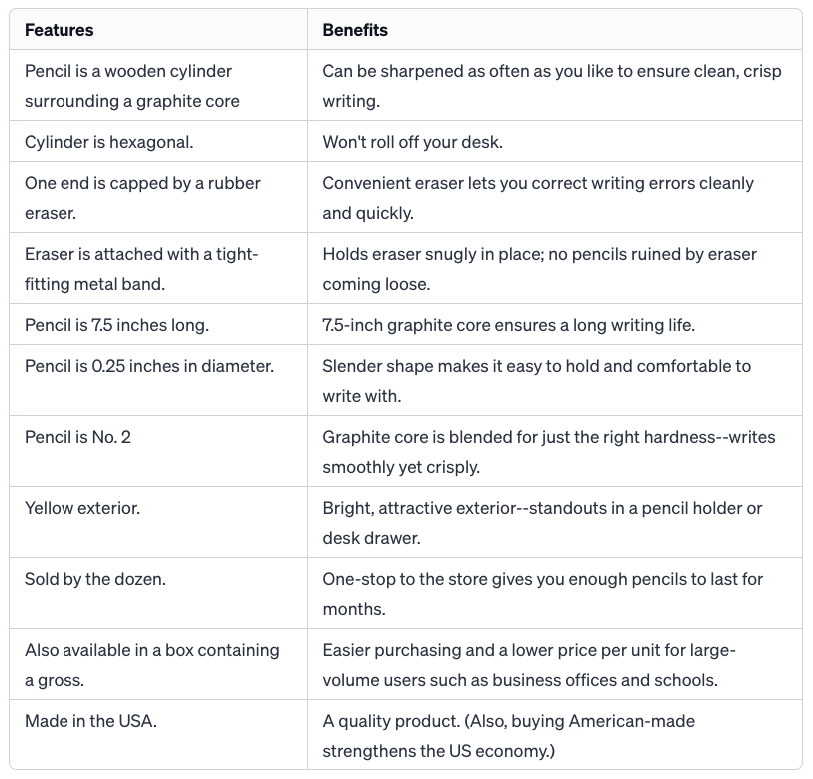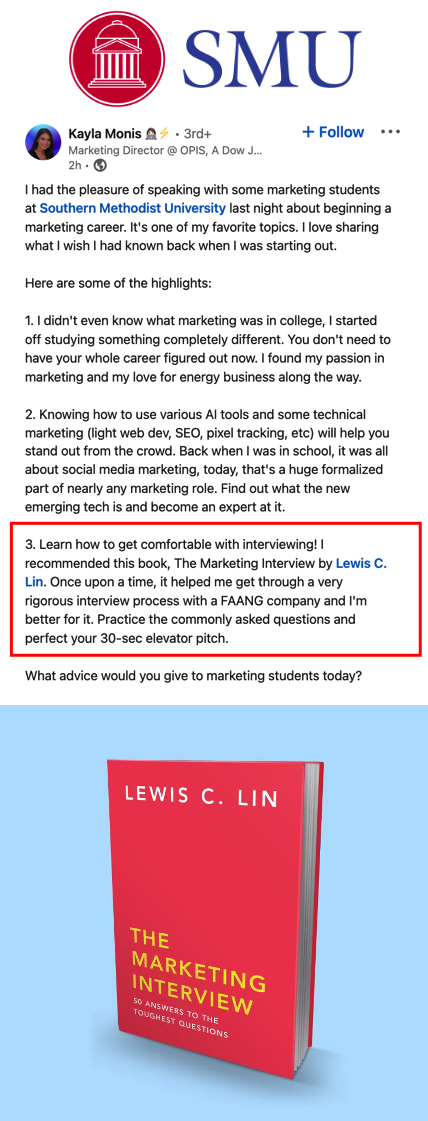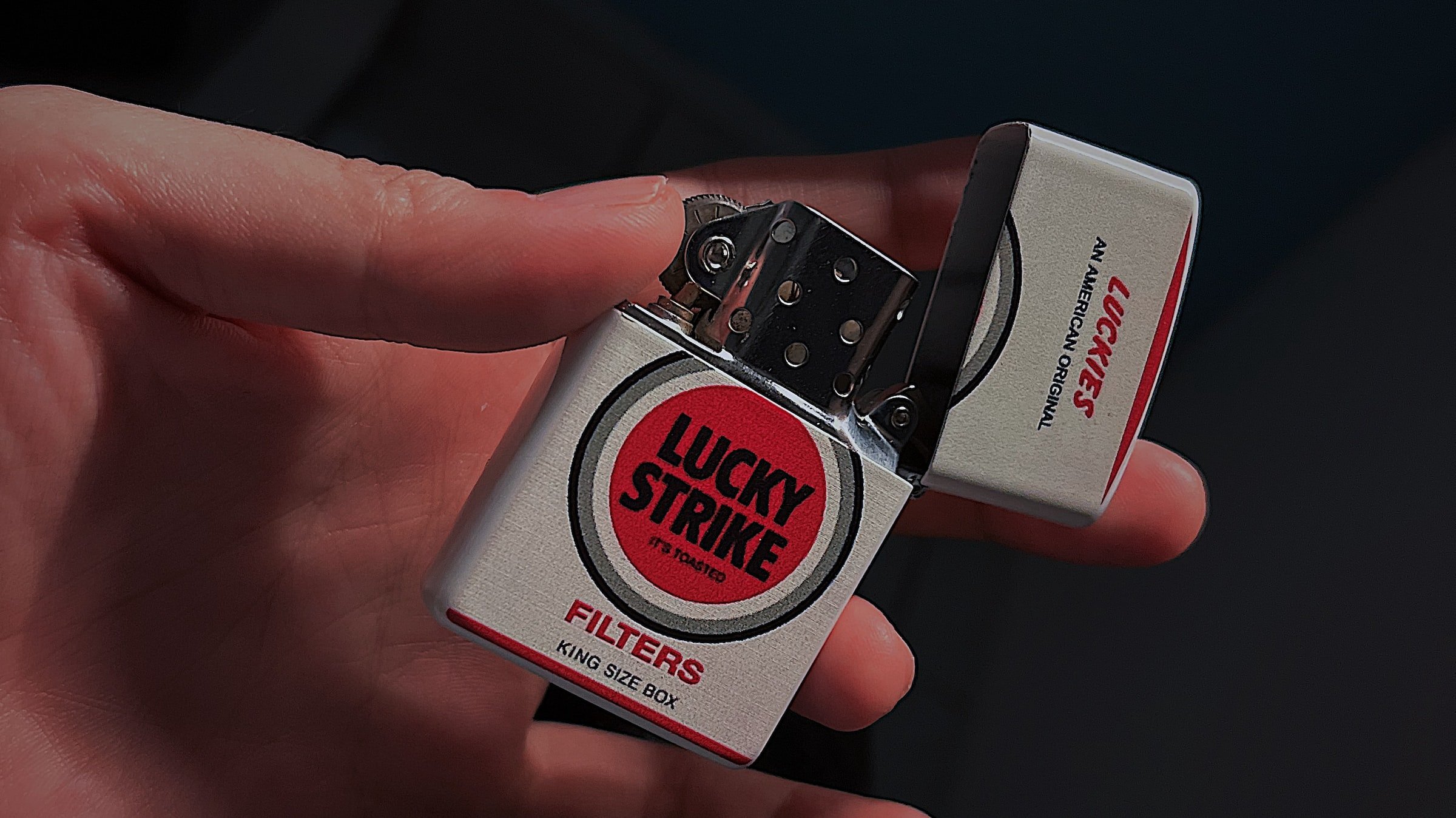I absolutely love marketing, and Mattel is one of the best consumer brands out there.
So naturally I’m thrilled to hear that one of my UCI workshop attendees used my materials to secure a coveted offer from Mattel this summer!
🙌
Marketing
I absolutely love marketing, and Mattel is one of the best consumer brands out there.
So naturally I’m thrilled to hear that one of my UCI workshop attendees used my materials to secure a coveted offer from Mattel this summer!
🙌


I've been reading Robert Bly's book, "The Copywriter's Handbook," where he effectively emphasizes the significance of documenting a product's features and benefits.
The exemplary breakdown of the features and benefits of a standard yellow pencil within the book stands out as one of the most impressive, clear, concise, and jargon-free explanations I've ever come across.

This pencil example is something I’ll refer to again and again, so I’ve included the plain text below.
Pencil is a wooden cylinder surrounding a graphite core - Can be sharpened as often as you like to ensure clean, crisp writing.
Cylinder is hexagonal - Won't roll off your desk.
One end is capped by a rubber eraser - Convenient eraser lets you correct writing errors cleanly and quickly.
Eraser is attached with a tight-fitting metal band - Holds eraser snugly in place; no pencils ruined by eraser coming loose.
Pencil is 7.5 inches long - 7.5-inch graphite core ensures a long writing life.
Pencil is 0.25 inches in diameter - Slender shape makes it easy to hold and comfortable to write with.
Pencil is No. 2 - Graphite core is blended for just the right hardness--writes smoothly yet crisply.
Yellow exterior - Bright, attractive exterior--standouts in a pencil holder or desk drawer.
Sold by the dozen - One-stop to the store gives you enough pencils to last for months.
Also available in a box containing a gross - Easier purchasing and a lower price per unit for large-volume users such as business offices and schools.
Made in the USA - A quality product. (Also, buying American-made strengthens the US economy.)
Can be sharpened as often as you like to ensure clean, crisp writing.
Won't roll off your desk.
Convenient eraser lets you correct writing errors cleanly and quickly.
Holds eraser snugly in place; no pencils ruined by eraser coming loose.
7.5-inch graphite core ensures a long writing life.
Slender shape makes it easy to hold and comfortable to write with.
Graphite core is blended for just the right hardness--writes smoothly yet crisply.
Bright, attractive exterior--standouts in a pencil holder or desk drawer.
One-stop to the store gives you enough pencils to last for months.
Easier purchasing and a lower price per unit for large-volume users such as business offices and schools.
A quality product. (Also, buying American-made strengthens the US economy.)
I’m honored to have Kayla, a talented marketing director at a Dow Jones company, recommend my book to marketing students from Southern Methodist University.
To those interested in diving into the world of marketing or preparing for interviews, check out The Marketing Interview. I’ve crafted this book to offer practical strategies and real-world scenarios that all marketers can benefit from.

When I receive messages from fans of my marketing interview book, it's a reminder of why I do what I do.
It's an honor to know that my work has helped so many people discover their passion for marketing. 🙏

In the world of advertising, the Mad Men series has left a lasting impression. The show's portrayal of the industry in the 1960s may seem dated, but its marketing strategies are timeless. One particularly noteworthy scene, featuring Don Draper and the Garner family, showcases the essentials of successful marketing.

Don Draper: This is the greatest advertising opportunity since the invention of cereal. We have six identical companies making six identical products. We can say anything we want. How do you make your cigarettes?
Lee Garner, Jr.: I don't know.
Lee Garner, Sr.: Shame on you. We breed insect repellant tobacco seeds, plant them in the North Carolina sunshine, grow it, cut it, cure it, toast it...
Don Draper: There you go. There you go.
[Writes on chalkboard and underlines: "IT'S TOASTED."]
Lee Garner, Jr.: But everybody's else's tobacco is toasted.
Don Draper: No. Everybody else's tobacco is poisonous. Lucky Strikes'... is toasted.
Roger: Well, gentlemen, I don't think I have to tell you what you just witnessed here.
Lee Garner, Jr.: I think you do.
Don Draper: Advertising is based on one thing: happiness. And do you know what happiness is? Happiness is the smell of a new car. It's freedom from fear. It's a billboard on the side of a road that screams with reassurance that whatever you're doing is OK. You are OK.
Lee Garner, Sr.: It's toasted.
[Smiles]
Lee Garner, Sr.: I get it.
The dialogue highlights the key message of the campaign: the toasting process of Lucky Strike cigarettes. They further differentiate it from other cigarette brands by calling the competitors “poisonous.”
The dialogue emphasizes how calling it “toasted” creates happiness and frees customers from fear, tapping into emotions that are relevant to the target audience. By connecting well-being with smoking Lucky Strikes and a sense of well-being, the campaign appealed to people's emotional needs.
"It's Toasted" is a simple, memorable, and easily understood tagline. Consistent repetition will create brand recognition and memorability. The tagline communicates the brand's key message, making it easy for the target audience to understand and remember.
This scene highlights the importance of having a clear USP, tapping into emotions, and using a simple yet memorable tagline. By setting Lucky Strike apart from other cigarette brands and linking it with happiness and peace of mind, the campaign made a lasting impact on consumers. The "It's Toasted" slogan still inspires marketers today, proving its effectiveness in creating brand recognition and memorability.
A radiant success story shines from one of our readers! With the help of The Marketing Interview, they landed not one, but two dream job offers - one in tech and the other at a top marketing agency. A decade of experience in their field combined with the strategies in our book proved to be a winning combination. And the best part? They're already putting the book's insights to work in their new role. A true testament to the power of knowledge and determination.

There are several reasons for the poor product names.
Uninspired marketers
There are simply some marketers who didn't care enough about their product to put proper effort into coming up with a good name. I would put Microsoft Family Safety in this category. And it looks like the executive in charge didn't care either.
Opinionated bureaucrats
Sometimes, the influential executives care too much. Decision makers with limited marketing experience start throwing ideas out. And unfortunately they're influential enough to have these bad names stick. That's why you get products with "RT" appended to it. Apparently RT doesn't mean real-time; instead it's much, much geekier. Yes, some engineering VP cried and moaned enough to get their way. Good luck explaining that one to a 55 year old small business owner. (Details: What Does the ‘RT’ In Windows RT Stand For?)
Indecisive and weak marketing leaders
The role of a strong marketing leader is to clarify the brand strategy & hierarchy. For example, P&G's leadership team made a conscious decision to have strong product names (e.g. Tide, Swiffer, Pampers). They opted out of using the corporate brand as an umbrella brand. In other words, it's not "P&G Tide" or "Procter and Gamble's Pampers." At Microsoft, there's no clarity around the brand strategy. Sometimes Microsoft is the umbrella brand e.g. "Microsoft Office." Other times, the umbrella brand is left out such as "Xbox" or "Bing." At other times, Microsoft uses multiple umbrella brands such as "Microsoft Windows Live Hotmail Premium." Microsoft has no shortage of run-on product names -- and it's largely because of indecision.